Not surprising, Gallup reports that for the second consecutive year, Panama leads the world in well-being, with 53% of residents considered thriving in three or more elements.
Americas Lead Highs, Sub-Saharan Africa Lows in Well-Being
This article is the first in a series exploring worldwide perceptions of well-being in the five well-being elements of the Gallup-Healthways Global Well-Being Index: purpose, social, financial, community and physical.
WASHINGTON, D.C. — About one in six adults worldwide are considered thriving — or strong and consistent — in at least three of the five elements of well-being, as measured by the Gallup-Healthways Global Well-Being Index in 2014. Residents of the Americas region are the most likely to be thriving in three or more elements (31.3%), while those in sub-Saharan Africa are the least likely (10.2%).
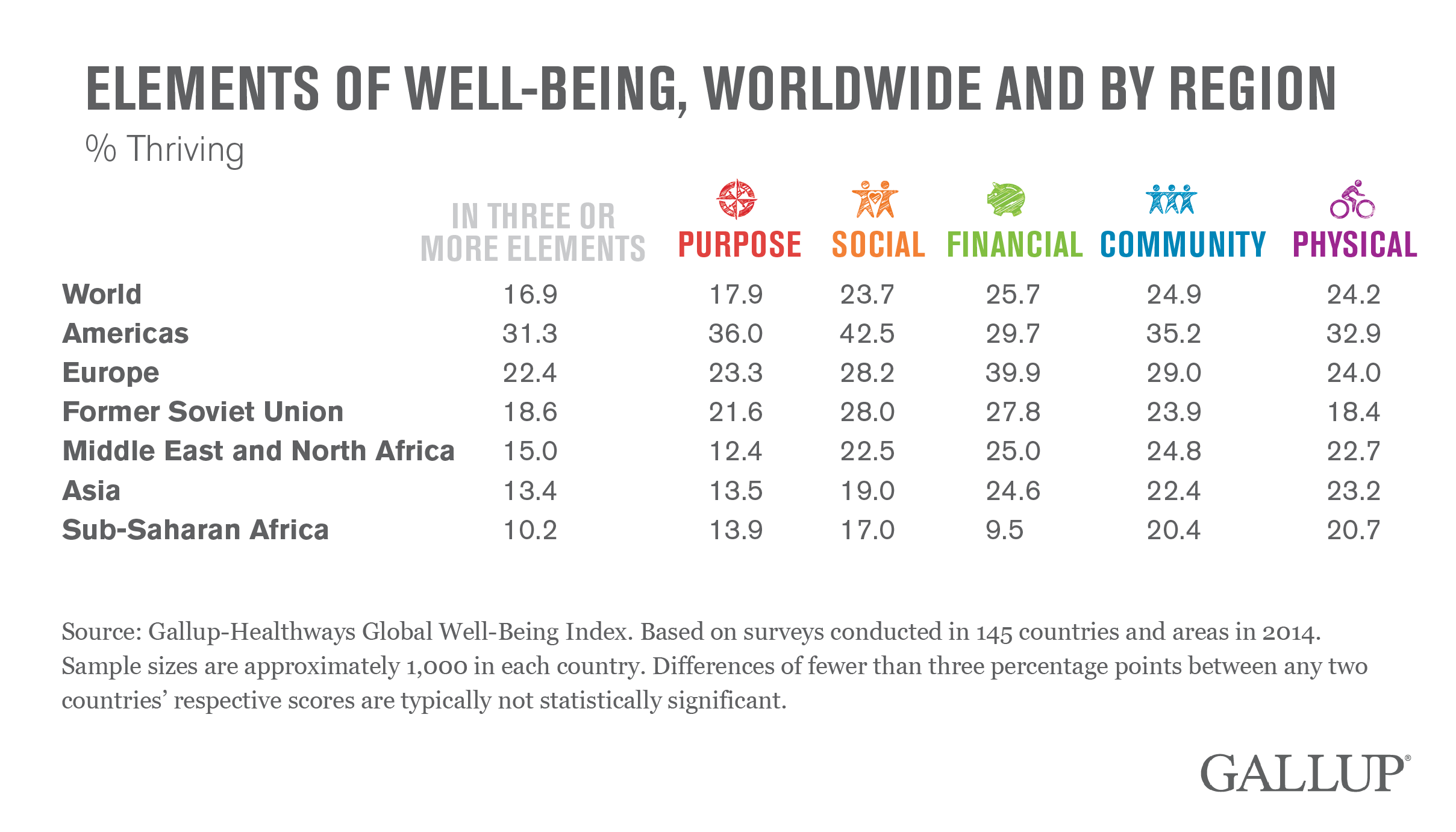
The Gallup-Healthways Global Well-Being Index is an extension of seven years of research and more than 2 million interviews in the U.S. through the Gallup-Healthways Well-Being Index. The Global Well-Being Index is a global barometer of individuals’ perceptions of their well-being and is the largest recent study of its kind. Data collection spanned 145 countries and areas and more than 146,000 interviews in 2014. The Global Well-Being Index is organized into the five elements:
- Purpose: liking what you do each day and being motivated to achieve your goals
- Social: having supportive relationships and love in your life
- Financial: managing your economic life to reduce stress and increase security
- Community: liking where you live, feeling safe and having pride in your community
- Physical: having good health and enough energy to get things done daily
In analyzing the results of the index, Gallup and Healthways classify responses as “thriving” (well-being that is strong and consistent), “struggling” (well-being that is moderate or inconsistent), or “suffering” (well-being that is low and inconsistent).
At the regional level, the Americas have the highest percentages of residents thriving in three or more elements and lead other regions in purpose, social, community and physical well-being. Latin Americans in particular have higher levels of well-being than any other regional group. Residents of many Latin American countries are among the most likely in the world to report daily positive experiences such as smiling and laughing, feeling enjoyment, and feeling treated with respect each day.
Panama Again Leads the World in Well-Being
For the second consecutive year, Panama leads the world in well-being, with 53% of residents considered thriving in three or more elements. Costa Rica and Puerto Rico round out the top three as the only other countries or areas with at least 45% or more of their populations thriving. Afghans, in turn, had the lowest well-being globally, with 0% of residents considered thriving.
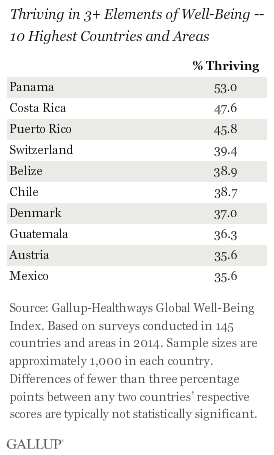
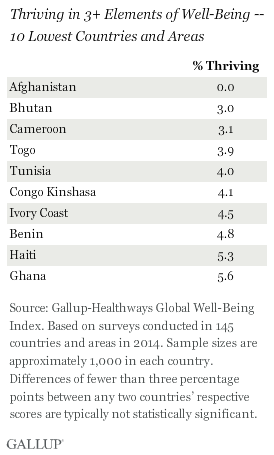
Panama Leads the World in Purpose and Physical Well-Being
For the second year, Panamanians have the highest levels of purpose well-being (60.5% thriving) and physical well-being (52.2% thriving). They also tie with other countries for the top spot in social and community well-being. Factors contributing to this peak level of global well-being may include Panama’s Latin American cultural predisposition that is associated with higher levels of positivity than other regions. Its relative political stability, a strong and growing economy in 2014, and investments in national development may also be contributing factors to higher levels of well-being in Panama.
Puerto Rico, Norway and Sri Lanka round out the list of top countries and areas in the individual elements of well-being:
- 63% of Puerto Ricans are thriving in social well-being.
- 68.9% of Norwegians are thriving in financial well-being.
- 50.1% of Sri Lankans are thriving in community well-being.
European countries are most likely to be thriving in financial well-being, with nine of the top 10 located in this region. Two in three or more residents in Norway (68.9%), Sweden (67.9%) and Switzerland (66.1%) are thriving in this element. Singapore (52.4%) is the only non-European country to have a majority of its population thriving in financial well-being.
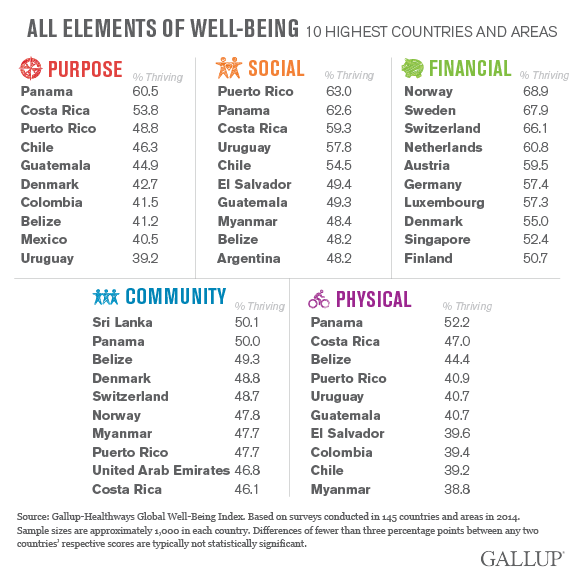
While several of the top 10 financial well-being countries also have the highest gross domestic product per capita, including Luxembourg, Singapore, Norway and Switzerland, other countries with the highest GDP per capita globally have residents who do not feel they have enough money to do what they want to do or have worried about money in the last seven days. For example, the U.S. is 10th globally in GDP per capita, yet it ranks 22nd in financial well-being on the Global Well-Being Index.
Afghanistan Ranks at the Bottom in Nearly All Elements
On the other end of the spectrum, Afghanistan ranks last in the percentage thriving in three or more elements, as well as in purpose, social and financial well-being elements. As a testament to the dire state of well-being in the country, Gallup could not categorize any Afghan resident among the 1,000 residents interviewed in 2014 as thriving in three or more elements, or in purpose or social well-being. An extremely low 2.7% of Afghans are thriving in financial well-being. Afghans rank second to last in physical well-being, with only 8.3% of residents categorized as thriving in this element. Community well-being is the only element for which Afghanistan does not rank among the bottom 10 countries globally.
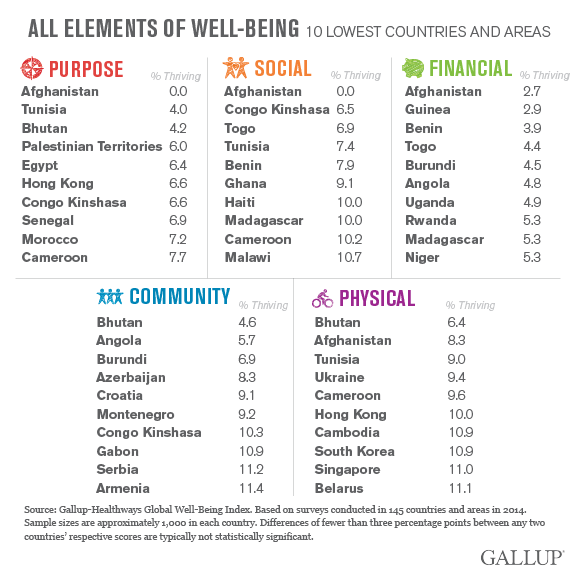
Implications
Gallup and Healthways’ research shows that people worldwide with higher well-being are healthier, more productive and more resilient in the face of challenges such as unemployment.
“Through scientific and peer-review research, we know that improving a population’s well-being has a significant impact on increasing performance and lowering healthcare costs. The fact that only about 17% of the adults Gallup surveyed are thriving in three or more elements of well-being underscores that many countries struggle to achieve high well-being. This represents a huge opportunity for country and community leaders, employers, insurers and any population health stakeholder. There are proven interventions that these leaders can and should leverage to improve the health and well-being of their population and, at the same time, create measurable economic value,” said Peter Choueiri, president of Healthways International.
Subjective well-being does not necessarily correlate with GDP, the presence of conflict or other absolute indicators. War-torn populations such as those in Afghanistan may have extremely low well-being, but Gallup and Healthways also found low levels of well-being in countries that are relatively stable, such as Croatia, South Korea and Singapore.
The 2014 Gallup-Healthways Global Well-Being Index results have policy implications for country leadership, development organizations, employers, health insurers (private and governmental) and others. Leaders can use the Global Well-Being Index to establish a baseline for well-being, benchmark their populations, determine where gaps exist in essential services or opportunities, prioritize and implement interventions, and, ultimately, understand the effects of their investments.
Access the Gallup-Healthways State of Global Well-Being: 2014 Country Rankings.
Survey Methods
Results for the Gallup-Healthways Global Well-Being Index are based on telephone and face-to-face interviews on the Gallup World Poll, with a random sample of more than 146,000 adults, aged 15 and older, living in 145 countries and areas in 2014.
For results based on the total sample of national adults, the margin of sampling error is less than ±1 percentage point at the 95% confidence level. For results based on country-level samples, the margin of error ranges from a low of ±2.2 to a high of ±5.2.
All country-level analyses use country weights. Global and regional analysis uses projection weights that account for country size. Minimum sample sizes of 300 apply.
In addition to sampling error, question wording and practical difficulties in conducting surveys can introduce error or bias into the findings of public opinion polls.
Each element in the Global Well-Being Index contains two items asked of all respondents:
Purpose
- You like what you do every day.
- You learn or do something interesting every day.
Social
- Someone in your life always encourages you to be healthy.
- Your friends and family give you positive energy every day.
Financial
- You have enough money to do everything you want to do.
- In the last seven days, you have worried about money.
Community
- The city or area where you live is a perfect place for you.
- In the last 12 months, you have received recognition for helping to improve the city or area where you live.
Physical
- In the last seven days, you have felt active and productive every day.
- Your physical health is near-perfect.
